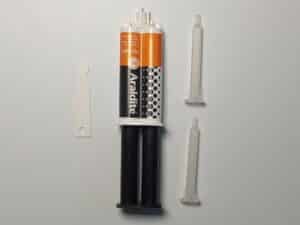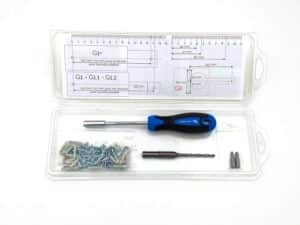197,00€ w/o VAT per box 5 units

Technical specifications
|
||||
Presentation of the G1.3 gauge for wide-gap cracksThe G1.3 gauge has been designed to measure large cracks. The tool can measure structural variations of up to 17 cm with an accuracy of 0.1 mm. This gauge is also suitable for developments with a large initial gap, with a fixing capacity of up to 25 cm centres in standard use. It has a wide range of applications in the building industry:
|
||||
Summary of the strengths of the G1.3 gauge for large cracksThe G1.3 gauge offers a number of advantages for monitoring large cracks: accuracy, fixing, simplicity, readability… Find out more about the 6 strong points of this product. Measurement accuracyThe large crack gauge uses a vernier scale accurate to 0.1 mm for fine, detailed measurements. Mounting optionsThe product offers two mounting options:
This flexibility makes it easier to adapt to the specific characteristics of a substrate, for example, to follow up a large crack in a stone façade, or a large crack in the interior walls of a house. Patented installation systemThe gauge is fitted with a folding bar inserted into an oblong hole on the pull tab. This unique system makes it :
Gauge structureThe G1.3 gauge consists of a scale graduated from 0 to 20 cm, sliding on a dial. As an option, a 50cm ruler can be supplied to replace the 20cm ruler supplied by default. Measurement trackingA built-in table allows you to note the dates and readings of measurements directly on the gauge. In addition, each gauge is uniquely identified with a QR code and an identifier. This identification enables measurements to be collected and monitored directly in the Saugnac application supplied free of charge. |
||||
How do you read the evolution of a crack with the G1.3 gauge?
|
||||
How do you track a large crack with an amplitude greater than 20 cm?The ‘standard’ use of the large crack gauge is with a 20 cm ruler as shown. However, for larger wall cracks, we offer two solutions. A 50 cm rulerThe first solution is to replace the 20 cm ruler with a 50 cm ruler to appreciate a greater variation in amplitude. Contact us to order this made-to-measure solution. Variant without rulerThe other solution for very wide cracks is to abandon the standard ruler and use 2 G1.3 gauge bodies through which a metal metre passes. The metal ruler is fixed on one side and slides into the 2 gauge bodies, allowing the reading to be taken.
|
||||
Download the Saugnac.app application to track your measurementsThe Saugnac web application, which is completely free with no restrictions, is available on PC or smartphone from https://saugnac.app. It allows you to : – identify each G1.3 gauge and its measurements with its unique QR code Find out more about how the application works |

Fast-curing epoxy adhesive in a twin-syringe for reinforced bonding in cases of significant surface roughness or high moisture

Mechanical fixing kit for surfaces unsuitable for self-adhesive installation (includes 1 drill bit + 1 PZ1/PZ2 screwdriver + 40 wall plugs and screws)

Bag of 50 anchors and screws for mechanical fixing on surfaces unsuitable for self-adhesive mounting
Pour obtenir un devis ou nous poser des questions sur le produit, n’hésitez pas à nous contacter :
If you would like a quotation or have any questions about the product, please contact us: